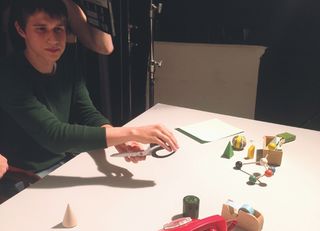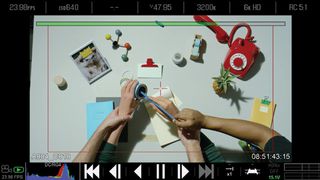How a top Canadian studio made technology tangible for Samsung
Canadian studio Vallée Duhamel illustrates Samsung's S-Pen functionality beautifully.
05. Test before going on set

Always test before going on set. Once we had worked out the order, we had several rehearsals. The aim was to figure out the way Émilien needed to start and finish the movement of each object, so that it was hidden and could be subsequently revealed.
Everything was shot in live action, so it was a meticulous task of positioning the beginning and end of his movement between the object's substitution.

But a couple of shots were comped together at the end. For example, when he put his hand in the desk and reached for the notepad, this was shot in three different takes.
The first one to get objects behind his hand, the second one on green-screen for objects in front of his hand, and a last one of the hand reaching the notepad. We used Adobe Premiere Pro and Adobe After Effects to make these tests.
06. Always share new ideas

When a better idea comes up in the process, share it with the client, even if you are past the established calendar. The creative process should always be part of each step, from conception and storyboard to shooting day and post-production.
07. Work with a video assistant

On set, we worked with a video assistant who provided us with a live image, played previous takes and roughly blended two takes together to make sure all the positions matched. This enabled us to have a skin of the previous shot and to match the arm positions so we could continue the movement in the sequence.
In total we used about 30 different objects including the ones on the desk. All of them were carefully chosen from different designers we like. The final shoot took two days of 16 hours in a row. That was pretty intense.
08. Get clint feedback

The entire process went extremely well. Heaven and Samsung had faith in our direction. We received helpful feedback on the different aspects that needed to be related to the features of the S-Pen, and they were open to the way we adapted them while retaining the spirit in the storytelling.
When everyone involved in such projects performs their role well, it's hard to fail at reaching the targeted audience. We are so happy with the audience reaction – it has been our most viral project so far, with more than three million views in two weeks.
The full version of this article first appeared inside Computer Arts issue 238.
Half-price Computer Arts subs offer!

To celebrate 2015 degree show season, you can get an incredible 50 per cent off an annual subscription to Computer Arts magazine. For £39 you'll receive 12 months of industry insight, opinion and inspiration, delivered to your door.
Plus: sign up by 7 July 2015 and you'll receive Computer Arts' New Talent issue, featuring an extensive guide to 2015's most outstanding design graduates.
Liked this? Try these...
- How a leading London airport was rebranded for the future
- How to make the perfect exhibition take-away
- Hands-on review: Adobe After Effects CC

Thank you for reading 5 articles this month* Join now for unlimited access
Enjoy your first month for just £1 / $1 / €1
*Read 5 free articles per month without a subscription

Join now for unlimited access
Try first month for just £1 / $1 / €1
Get the Creative Bloq Newsletter
Daily design news, reviews, how-tos and more, as picked by the editors.
The Creative Bloq team is made up of a group of design fans, and has changed and evolved since Creative Bloq began back in 2012. The current website team consists of eight full-time members of staff: Editor Georgia Coggan, Deputy Editor Rosie Hilder, Ecommerce Editor Beren Neale, Senior News Editor Daniel Piper, Editor, Digital Art and 3D Ian Dean, Tech Reviews Editor Erlingur Einarsson, Ecommerce Writer Beth Nicholls and Staff Writer Natalie Fear, as well as a roster of freelancers from around the world. The ImagineFX magazine team also pitch in, ensuring that content from leading digital art publication ImagineFX is represented on Creative Bloq.
